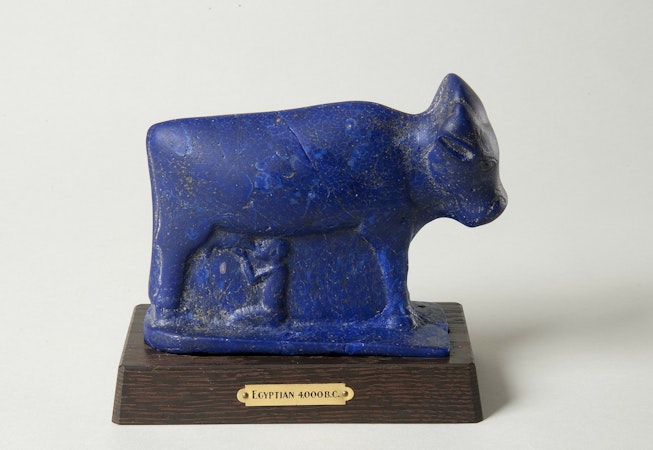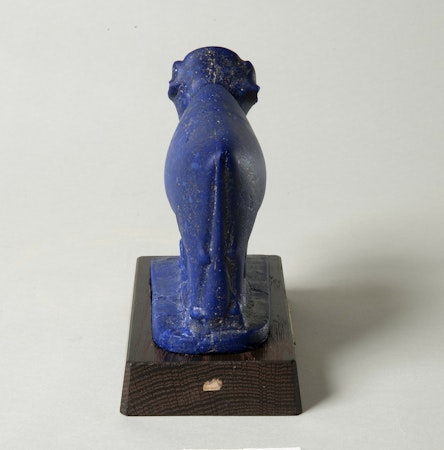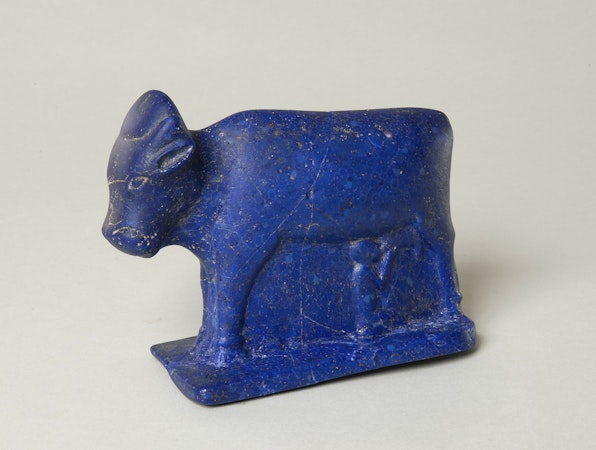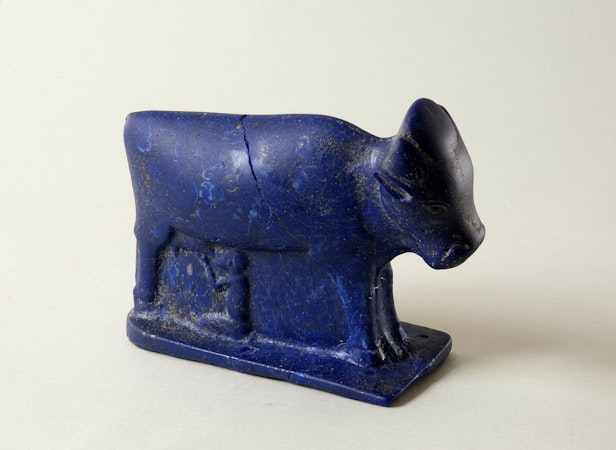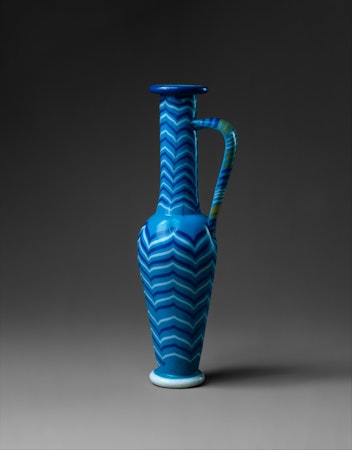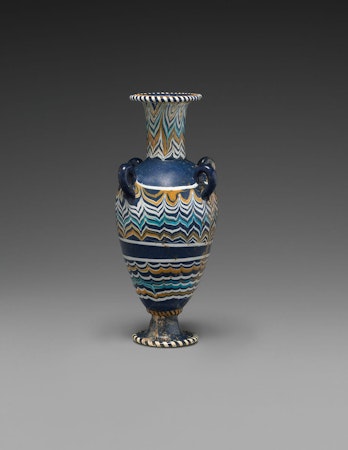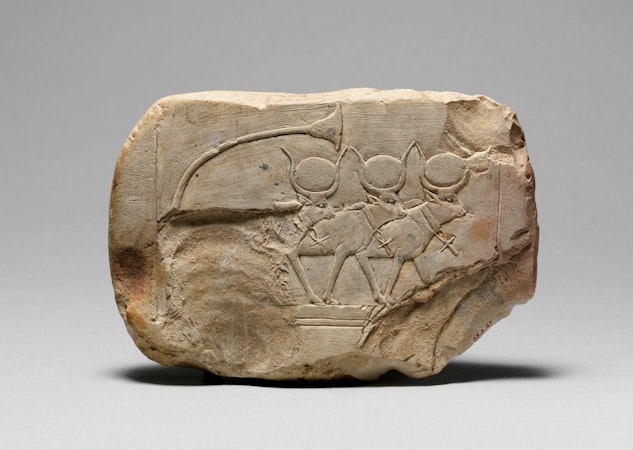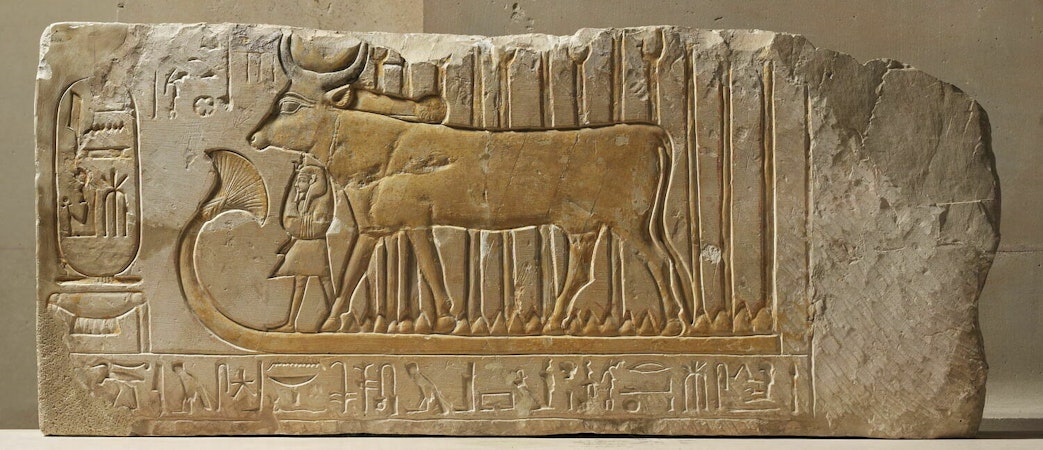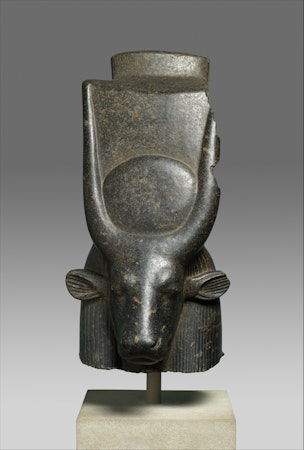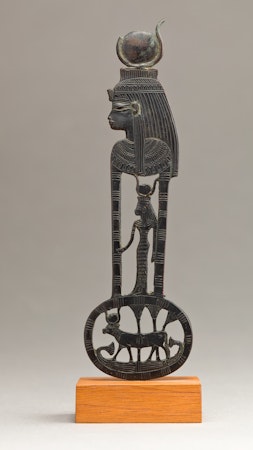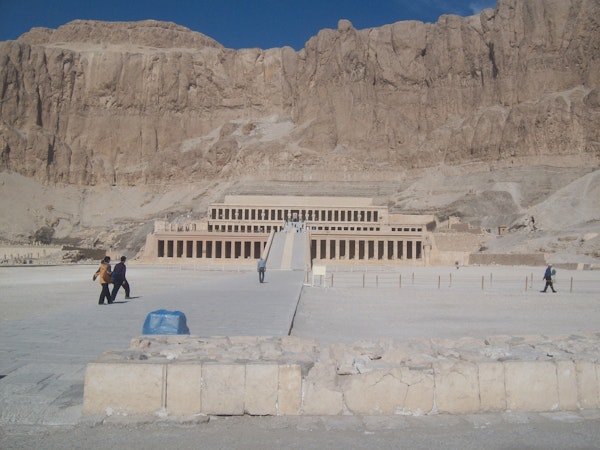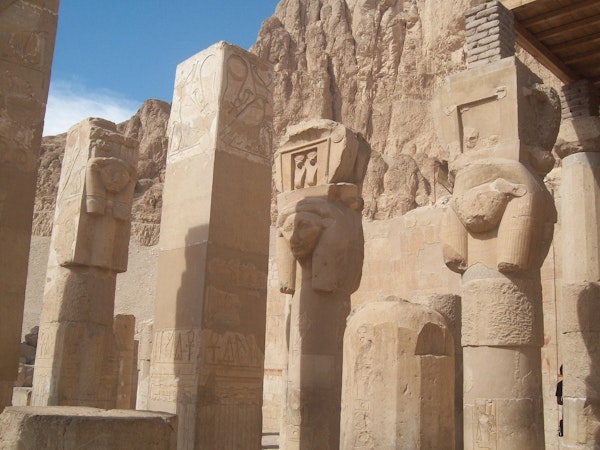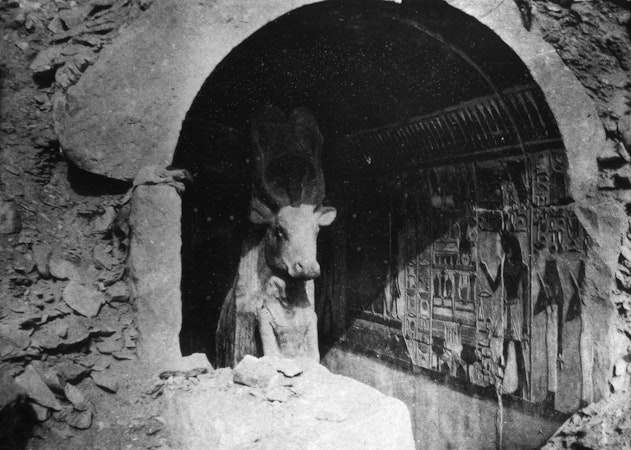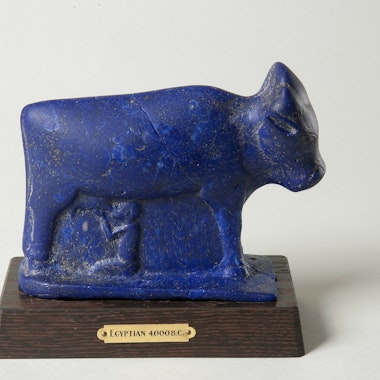
Unidentified artist. Statuette of a Cow, 19th–20th century. A68. Public Domain.
Holy Cow! Uncovering an Egyptian Glass Forgery
Carl Walsh, Postdoctoral Research Fellow
December 2021
Nearly any collection of Egyptian objects could have a fake ancient artifact hidden in its midst. Forgeries are intended to deceive—to pass as authentic works by specific artists or belonging to specific cultural traditions. Forgeries of Egyptian objects are common, with a long history that continues even today—most recently, with the exposure of the Sadigh Gallery in New York City, which for decades mass-produced fake antiquities that even infiltrated traveling exhibitions.
During the 19th and early 20th centuries—when Dr. Albert C. Barnes was purchasing Egyptian objects for his collection—Egyptomania was rippling through Europe and North America.¹ Barnes had a keen eye for contemporary modern painting that allowed him to spot a fake: correspondence in the Foundation archives reveals that he identified forged Renoir drawings on the art market and purchased an El Greco painting simply to study it and prove it was a forgery.² However, Barnes knew little about ancient art, and he inadvertently purchased several forgeries that are only now being identified.

Fig. 1: View of the ensemble on the east wall of Room 16 of the Barnes collection.
An ancient Egyptian glass cow?
One recently discovered forgery is a small blue glass cow statuette (A68), found in the top corner of a case of antiquities in Room 16 (Fig. 1). You can easily spot this statuette because of its vivid cobalt blue color, which balances with the blues of nearby Navajo jewelry, medieval Christian and Islamic manuscripts, and paintings by Alfred Henry Maurer and Charles Prendergast. Leaning in closer, you can see that the standing cow has a squat sun disk between its curling horns (Fig. 2) and a kneeling figure that suckles from its udders, which is mirrored on the other side of the statuette.
Though the image might seem strange, there are comparable examples in Egyptian art. The cow with a sun disk represents the animal form of the goddess Hathor, a protective diety associated with music, love, and the realm of the dead. The figure suckling from her udders is usually a pharaoh. The meaning of this scene will be explored further below, as it provides some clues about the object’s authenticity.
Barnes bought the statuette from the Paris dealer Georges Manolakos in December 1923, as part of a larger purchase of Egyptian and Greek objects. It was labeled in the purchase list as a “sacred cow,” dating to 2000 BCE, and purchased for 3,000 francs, a rather hefty sum compared with some of the other Egyptian antiquities. Manolakos provided no information about its provenance, the purchase and ownership history that might help trace the piece to its original archaeological context and therefore confirm its authenticity. If this information is lost or incomplete, the object’s authenticity becomes questionable, as its full history is not known.
Provenance is important not only for addressing authenticity but also for tracing earlier conservation and restoration work and for identifying objects that may have been stolen from archaeological sites or museum collections. Unfortunately, most of the Egyptian objects purchased by Albert Barnes have no documented provenance beyond the initial dealer he bought them from. Because of this, we must look deeper at each object to determine its authenticity and the story behind the work.
What made this object suspicious?
When approaching questions of authenticity, researchers often start with a visual analysis. A close, careful inspection of an object can reveal irregular or suspicious features. After a long look at this glass cow in our conservation lab, I noted several oddities that made me doubt its authenticity.
First, the use of glass for this work is very unusual, as such statuettes typically have been made of faience (a porcelainlike material) or stone throughout most of Egyptian history. Glassmaking and glassworking were relatively new technologies for ancient Egypt, introduced or developed during the New Kingdom period (1550–1069 BCE). It was mainly used for producing small, luxury decorative objects, such as inlays, beads, earrings, amulets, and perfume vessels (Fig. 3). Ancient Egyptian glasswork is characterized by opaque hues of blue, green, red, yellow, black, and white. The limited range of glass objects was influenced, in part, by the continued use of traditional materials such as faience and precious stones like lapis lazuli and carnelian, which could achieve similar colors, textures, and reflectiveness.

Fig. 4. Images of the crystalline structures resulting from rapid cooling on the surface of the glass (author's photos).
The statuette also exhibits signs of modern glassworking techniques. Looking closely, you can see a distinct mold line running lengthwise down the cow (Fig. 2), which indicates the statuette was made in two halves that were combined, using a two-part mold. The surface of the glass also has geometric, scalelike patterns (Fig. 4); these are crystalline structures that formed through rapid cooling against the surface of the mold.
There is no known use of such two-part molds in ancient Egypt. Egyptian glass objects were more commonly made using simple open-faced terracotta molds (for inlays, amulets, and beads) or core-form casting (for perfume bottles). In core-form casting, hot glass would be poured over a model of the vessel made with clay and dung temper. While still hot, decorative colored glass could be melted into the object to produce multicolor designs and figures (Fig. 3). (For examples of amulets made from open-form molds, see the eye of Horus amulets in the necklace in Fig. 3d.)
A few large glass objects and sculptures exist, but they are very rare and appear to have been made through direct casting through the lost wax technique and further refined using lapidary techniques for precious stones. So, while Egyptian glassmaking did use molds, they were were reserved for small, flat objects, and were not the two-part type used for the Barnes statuette.
The appearance of the Hathor cow and suckling figure also deviate from Egyptian canon. The cow lacks the correct body proportions, the stylized Egyptian eye and eyebrows, and the thin, curving horns seen in most representations of the goddess (Fig. 5). Hathor cows are also more commonly depicted in striding poses, making the static, stiff legs of the Barnes cow irregular. The execution of figure of the suckling king is very basic, with no facial features or royal regalia such as a crown or scepter. The rounded body and limbs also lack the distinct rigidity used in representing the human body in Egyptian art.
What was the forgery based on?
Along with the oddities noted above, the motif of Hathor as a cow nursing a king is rare and limited to very specific contexts. The motif appears in reliefs, paintings, and statuary from the chapels dedicated to Hathor found in the temples of the New Kingdom pharaohs Hathsepsut and her nephew, Thutmosis III at Deir el-Bahri, Thebes (modern Luxor) (Fig. 6).³ It illustrates the divine origins of the king as Hathor’s son, who acquires her power by consuming her milk (Fig. 7). This intimate image was a strictly royal motif and only appears in restricted, sacred spaces in temples. Even in these cases, it is a relatively rare image, with only limited instances found outside of the Hathor chapels at Deir el-Bahri (Fig. 7).⁴ While the motif is found on cult statues of Hathor, small statuettes of this motif are completely unheard of.
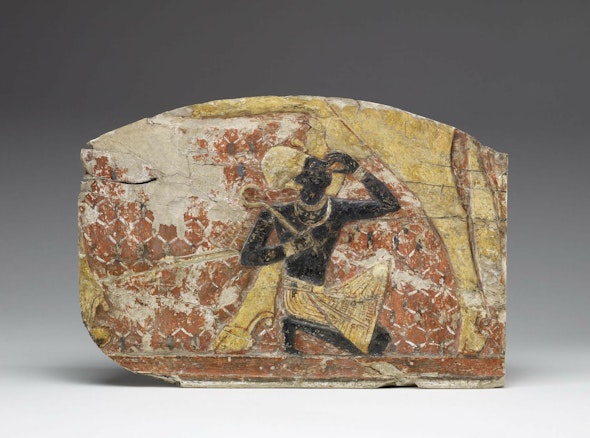
Fig. 7: Painted wall fragment of a Ramesside king suckling from a Hathor cow, New Kingdom, Walters Art Gallery (22.121).
Closer parallels for the Barnes statuette can be found in nonroyal images of Hathor cows, which are quite common, and appear in stone, terracotta, faience, and wood.⁵ Many examples have been found at the Hathor chapels and temples, especially at Deir el-Bahri, and were likely private dedications made by worshipers during festivals in honor of Hathor (Fig. 6). However, the Barnes cow is clearly not one of these objects, either, given the details of its production, and the statuette’s many irregularities convinced me that it was a modern forgery.

Fig. 8a. Faience and glass votive objects (fragments of a bowl, statuette, and amulets) from Deir el-Bahri, New Kingdom, British Museum, London (EA58908, 41020, 41054).
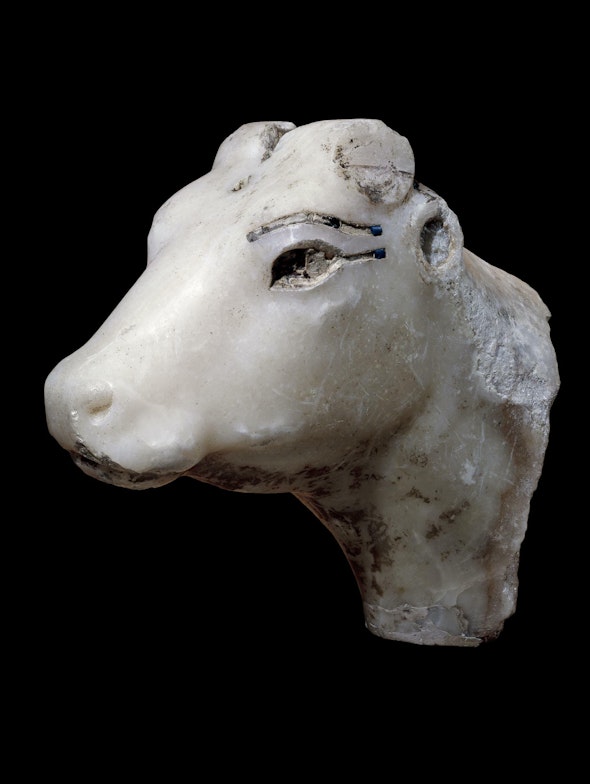
Fig. 8b. Fragment of a stone statuette of a Hathor cow, British Museum (EA42179).
The forger who made this statuette likely took inspiration from an authentic relief, painted scene, or statue/statuette/amulet of a Hathor cow. This is unsurprising, as this motif became quite popular in the 19th and early 20th centuries through the production of plaster casts, photographs, and painted reproductions of the reliefs from Deir el-Bahri. This led to the motif being incorporated into Egyptian revival styles of the time. The statuette’s color likely mimics the famous “Egyptian blue” of faience, a material Egyptians used to imitate the vibrant blues of lapis lazuli and turquoise. By harnessing Egyptian materials and colors, the forger made the statuette appear authentic. The general lack of knowledge regarding Egyptian glass production also helped the object to pass as a true artifact.
The Barnes forgery is a highly unusual one, though—I have found only one comparable statuette in blue and yellow glass, which appears to have circulated among private collections since the 19th century. This example depicts a Hathor cow with one male figure suckling from the udders and another holding a bowl near one of the cow’s forelegs. The style of cow and the strange frontally depicted man near the foreleg are certainly not Egyptian. However, the style is similar to the Barnes statuette, as is the dark cobalt blue, which incorporates a yellow marbling effect that perhaps mimics the gold veins of lapis lazuli. Images of the object also show evidence of the use of a two-part mold, with a clear line running lengthwise and a similar slant to that of the Barnes cow. This suggests that both objects are 19th-century forgeries and were perhaps even produced in the same workshop. However, further study would be needed to make an informed identification, including an examination of the object and its provenance records. Unfortunately, the object's current location is unknown.
Can the authenticity of the Barnes cow be determined through scientific methods?
Various scientific techniques are used to complement visual analysis in helping to determine an object’s authenticity. Nondestructive techniques, such as examination under infrared and ultraviolet light, can help identify out-of-place materials. X-radiography can detect concealed restoration or irregular materials. These techniques, however, provided little new information to help puzzle out the Barnes object’s authenticity.
Inorganic materials like glass cannot be dated with techniques such as radiocarbon dating. However, elemental analysis of the glass composition would allow us to compare it with authentic Egyptian glass objects and residues/raw materials from the ancient workshops at sites such as Amarna and Qantir;⁶ significant differences or the inclusion of elements not used by ancient Egyptians would indicate a modern production. Most testing of this type requires a sample of the object, which is usually destroyed in the process—making it a technique usually avoided unless necessary. Fortunately, a small fragment of the Barnes object was already available for testing, and our senior object conservator, Margaret Little, is having this sample’s elemental composition examined, which may yield more clues about its production.
What to do with a forgery?
Now that we have identified this object as a forgery, what do we do with it? Museums have a range of policies for dealing with forgeries. In many cases, they will remove a fake artifact from display as it no longer fits with their policy of presenting only authentic artworks. The ethical implications of forgeries are important to consider—by stimulating the market, fake antiquities can increase demand for real objects, encouraging the looting of archaeological sites and the robbery of museums. The recent conflict in Syria offers a humbling example of how forgery production provides enormous capital to fund conflict and facilitate the destruction of cultural heritage, seen particularly in the dynamiting of monuments at Palmyra by ISIS.
At the Barnes Foundation, however, we cannot remove any objects from the collection—not even the forgeries. Why? Well, these objects have been carefully positioned in Albert Barnes’s ensembles, or educational displays, making them historical documents that reflect his vision and teaching philosophy. Barnes’s intent in acquiring antiquities was to allow visitors and students to find connections in the techniques and plastic arts (color, line, lighting, and space) that artists used to express themselves, both across time and through different cultural traditions. These antiquities still have value in representing not only elements of Egyptian art but the historical perceptions of Egyptian art in Europe and North America during the 19th and 20th centuries. Some of the Egyptian forgeries in the collection even have noticeable influences from Egyptian revival and art deco styles, which illustrate how Egyptian art in popular culture influenced people’s perception of what was authentic and what was fake.
Museums are beginning to discuss forgeries in their collections more openly, which improves research and detection and engages people on ethical issues. For example, the British Museum decided to display a Mesoamerican crystal skull that was found to be an 18th-century forgery in its own exhibit, presenting the object’s story for audiences to read. This allowed a transparent process on how scholars detect forgeries, while providing an engaging story for visitors.
At the Barnes, we are also openly discussing these objects, through articles like this, and also through collaborative research with other scholars and museums, and updates to the object information on our online catalogue. Recently, I taught a course about fakes and forgeries with Kaelin Jewell, a senior instructor in adult education. We used forgeries in the collection to discuss concepts of authenticity and difficult questions about museum collection practices, the history of archaeology, the nature of the art market, and the impact of forgeries on cultural heritage. These objects also raise interesting questions about our own ideas of authenticity and whether modern reproductions of antiquities such as replicas, casts, restorations, and digital models can be seen as art.
Have a closer look . . .
I hope the story of the Barnes cow encourages you to have a closer look at the object in Room 16. Though a product of deception, it is a fascinating object with its own history and role in the ensemble. It also is a glimpse into a forger’s vision and expression of Egyptian visual culture, which fits into Albert Barnes’s exploration of the artist’s perception. And while Barnes certainly was concerned with having authentic works in his collection, this forgery provides another layered perspective on human visual cultures that works to further our experience of art. What connections can you find between this statuette and other objects in this case?
Endnotes
¹ Jean-Jacques Fiechter, Egyptian Fakes: Masterpieces That Duped the Art World and the Experts Who Uncovered Them (Paris: Flammarion, 2009).
² Albert Barnes purchased this painting in 1936 from a New York gallery for the purpose of exposing it as a forgery. An x-ray examination found an earlier work underneath, which was revealed by stripping multiple paint layers. The painting had been heavily “restored,” and after this discovery, Barnes attempted to force the dealer to admit it was not authentic and have his money returned, even writing a short article about the process intended for Art News. He settled with the dealer and did not publish the article, but a copy is available in the archives and was found by Director of Archives, Library, and Special Collections Amanda McKnight.
³ Geraldine Pinch. Votive Offerings to Hathor (Oxford: Griffith Institute, Ashmolean Museum, 1993).
⁴ Pinch, Votive Offerings to Hathor.
⁵ Pinch, Votive Offerings to Hathor, 160–83.
⁶ Thilo Rehren, Edgar Pusch, and Anja Herold, “Qantir-Piramesses and the Organisation of the Egyptian Glass Industry (Rehren et al 2001),” ed. Andrew Shortland, The Social Context of Technological Change: Egypt and the Near East, 1650-1150 BC (Oxford: Oxbow, 2001), 223–38.
